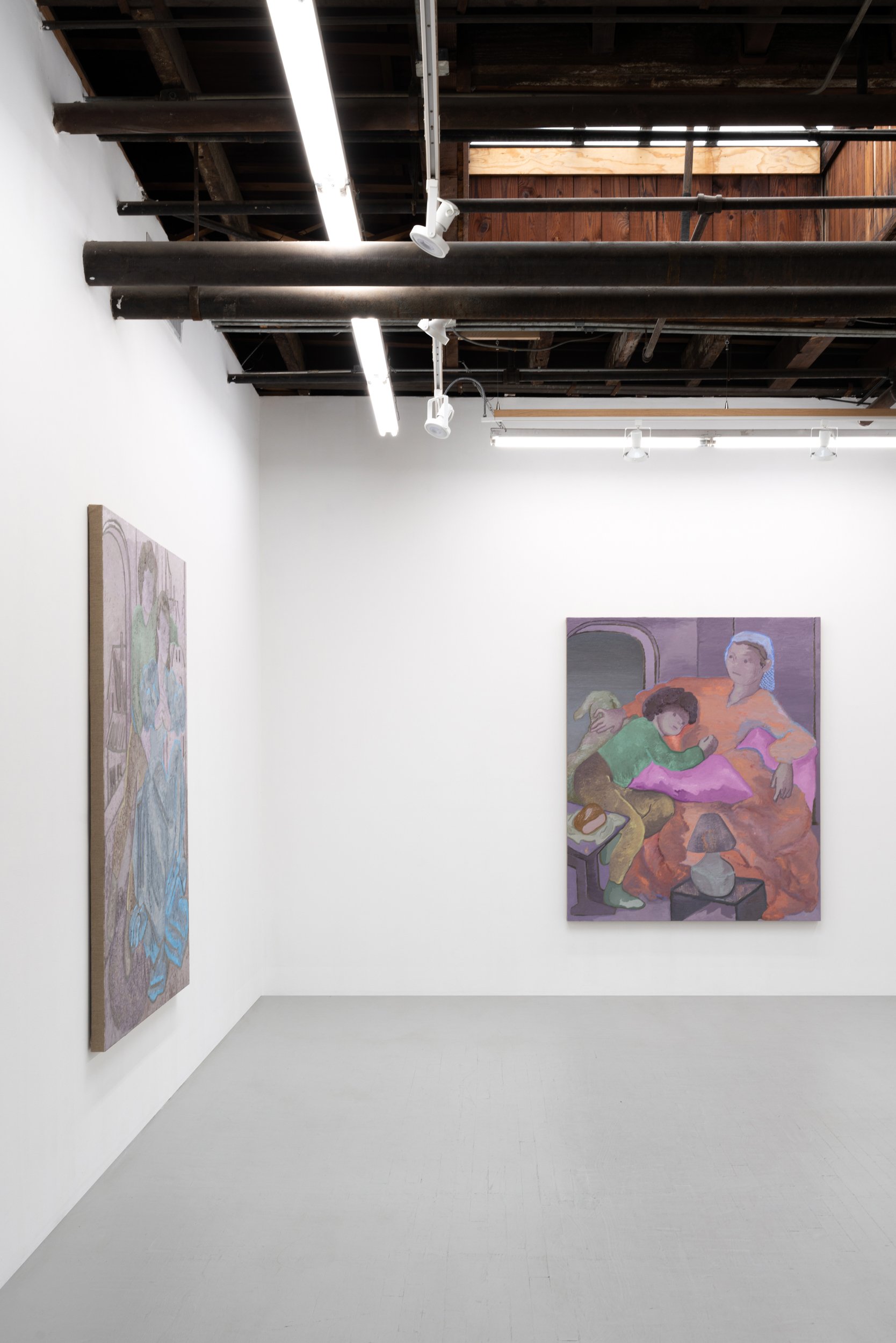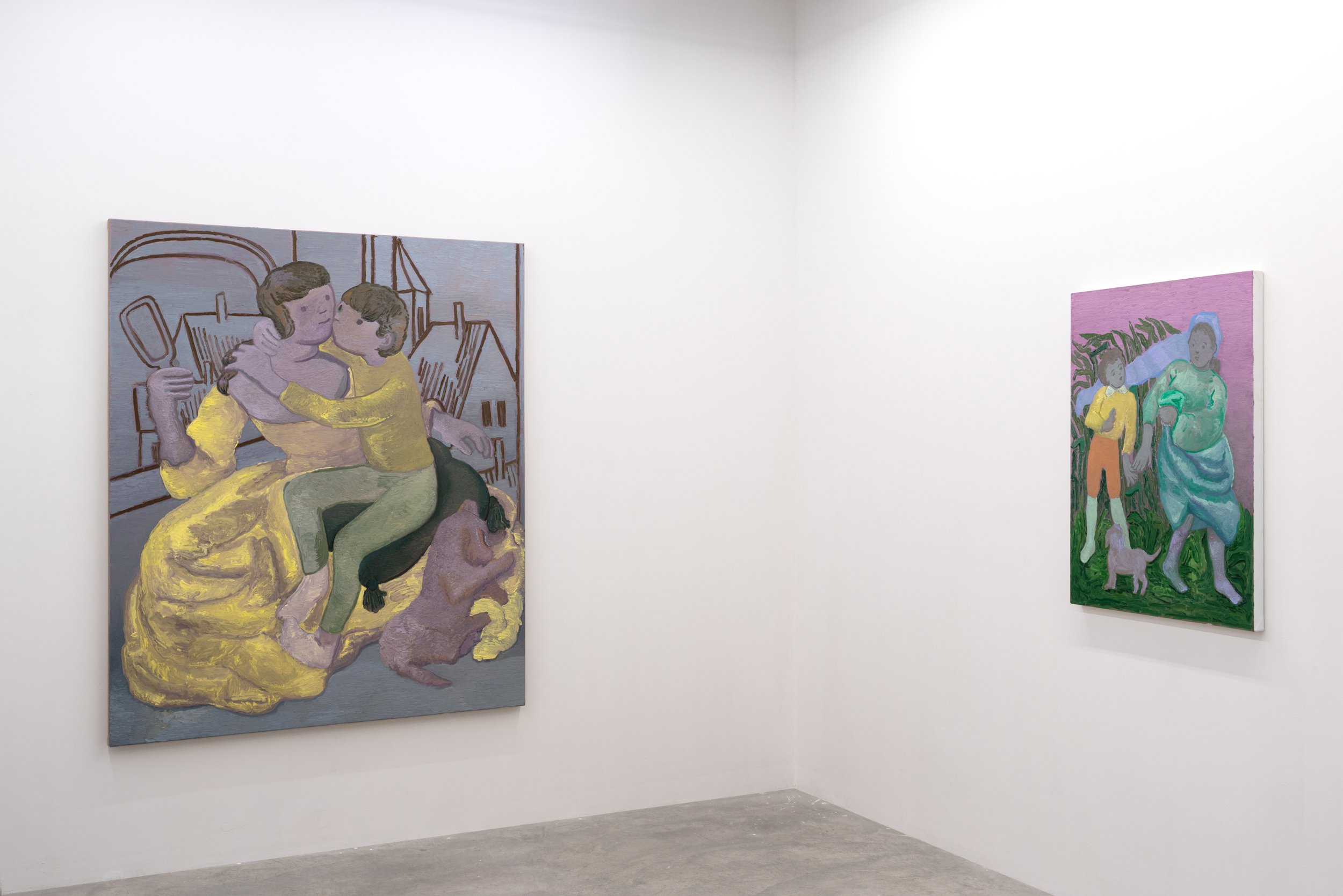DELPHINE HENNELLY
POSSIBLE WORLDS, COUNTERFACTUALS, AND THE DARK OF THE NIGHT SKY
ON VIEW NOW THROUGH 01.07.23
ESSAY BY SARAH HOOVER
CARVALHO PARK is thrilled to announce the opening of Possible Worlds, Counterfactuals, and the Dark of the Night Sky, an exhibition of new works by Delphine Hennelly. The opening will be held on Friday, November 11, from 6 – 8 in the evening, with the artist in attendance. This exhibition marks Hennelly’s her first solo show with CARVALHO PARK, following her two-person exhibition History Lessons that inaugurated the gallery.
In these large-scale oil paintings on linen, Hennelly strives to upend the saccharine nature of conventional depictions of motherhood. Combining costumed archetypes of mothers and sons with a luxuriant, exuberant application of paint over grisaille drawing, she explores both her devotion to abstraction and formal painting, as well as the eternal, enduring narratives around the maternal. The exhibition includes seven figurative paintings alongside three still lives of floral arrangements in vases, decorated with loose forms resembling octopi.
At first glance, the writhing cephalopods seem like nothing more than elegant embellishments, a small detail of the porcelain vases, noticeable only because the works are painted large scale (each measures approximately the size of the artist’s wingspan). But an octopus, with its eight legs, must have an incredible ability to multitask, just like the mythical mother figure who seems to “do it all.” Using the biggest brain and most developed central nervous system of all invertebrate animals, octopi are social, can change the color of their bodies in a matter of seconds—for purposes of both communication and hiding—and utilize ink sacks, filled with a murky mucus that they can leak not only as a smokescreen to ward of a predator, but in the shape of their own bodies in order to cause confusion. In other words, they are wildly advanced and intelligent, incredibly human in their abilities; an apt metaphor to complement the figurative paintings.
It is surprising to discover, then, that after reproducing and laying eggs, young female octopi self-destruct immediately. They most often starve to death, but there are reports of octopi in captivity beating themselves against their cages, eating their own arms and tearing off their own skin. Before their children are even born, all female octopi seem to suffer a postpartum depression so severe that they kill themselves.
Hennelly’s figurative paintings could be seen to answer the viewer’s questions about what, exactly, a female octopus is saving herself from. There is, of course, the horror of the identity rupture that a new mother is confronted with, wherein everything about her life is explosively changed in an instant; every ounce of herself that she has finally reckoned with being changed in ways she could have never imagined. There is the oppressive weight of worry, the burden of shouldering the potential pains that might befall a child, including the worst case, universe-ending scenario of a child’s loss, which the long art history of maternal pain as seen in religious Pieta scenes exemplifies. And there is the contradictory feeling that while a mother’s sole purpose is to care for and protect her young progeny, whose wellbeing is of vital importance to both the future of humanity and the emotional life of the parent, to do so is not always natural. The myth of inherent “maternal instincts,” a natural phenomenon of all truly good girls, does not explain the paradox that childcare can be boring and mindless and miserable to the point of making a mother dismayed by her life and judgmental of herself and even, sometimes, if we are being truthful, exhausted by her kid.
In painting titled after the exhibition, Possible Worlds, Counterfactuals, and the Dark of the Night Sky (2022), the figures’ flat, cartoonish faces indicate no specific emotion. In the vein of Ida Applebroog, their humanness is only indicated; simplified features designate mouth and eyes formed from hollow dashes of brownish paint. One vacillates between reading the mother’s grasp of the child as loving, or maybe comforting, to her clear disinterest and annoyance. It is almost as if whatever emotion the viewer themselves feels can be imparted upon the generic faces, offering their blanket formats for our bespoke interpretations. The broad swaths of muted jewel tones are made lively by impastoed brushwork in complimentary shadings, and while the long-skirted dress and headscarf of the mother seem to reference historical depictions of the Virgin Mary, the simplification of forms belies any possibility of placing this scene in a specific time period or identifying it as coming from a particular source. In fact, Hennelly finds inspiration as varied as medieval woodcuts, icon paintings, and 19th century postcards. These hybrid figures, therefore, deny the possibility of directly autobiographical storytelling.
Other works, like Walls of the Imaginable, Horizons of the Possible (2022), are even more opaque in narrative meaning. It is unclear whether the child is reaching upwards pleadingly or in excitement, and if the mother is leaning backwards in motion, on the precipice of diving in for an enthusiastic hug, or avoiding his touch all together. The striated material of her gowns leans towards abstraction and does not seem to indicate movement in a particular direction, and the lack of defined facial features keeps the viewer guessing. Perhaps the interpretation depends entirely on the emotional state and trauma history of the person reading into this visual language. There is a scientific phenomena known as “delusional companion syndrome,” wherein humans begin to attribute their own emotional range to inanimate objects, a sort of pathological animism. This urge to humanize anything that resembles a figure speaks to our most basic need for connection—an enduring point underneath Hennelly’s series of paintings.
“Is it okay that we are sometimes a shell of ourselves for these little people,” the artist asks me when we speak. I tell her that in my opinion, it is only natural. Sometimes even the most instinctive mother has to fake it, has to perform what she thinks motherhood should be. In these paintings, mothering is not treated with some sort of phony reverence, wherein culture pretends to respect the position as part of the pure Madonna, the well behaved and polite woman—while limiting our bodily autonomy and political freedoms behind closed doors. These works are too honest for that. They accomplish instead a depiction of the full breadth of maternal experience, in all its irrefutable and immutable truth. — SARAH HOOVER
Delphine Hennelly (b. 1979, Vancouver) lives and works in Montréal. She received her BA from the Cooper Union in 2002 and her MFA from Mason Gross School of the Arts at Rutgers University in 2017. She is a three-time recipient of The Elizabeth Greenshields Foundation Award. Hennelly has exhibited extensively in the US and internationally with Projet Pangée (Montreal); Carvalho Park (Brooklyn / Seoul); Waldburger Wouters (Brussels / Basel); Pt.2 Gallery (Oakland); Lisa Kandlhofer (Vienna); Cassina Projects (Milan); David Zwirner Platform; among others. In 2022, Hennelly was a resident artist of Palazzo Monti (Brescia).
Sarah Hoover is a writer based in New York, who holds a Masters in Cultural Theory from Columbia University and a BA in Art History from New York University. For fifteen years, she served as a dealer, artist liaison, and director of Gagosian gallery. She is on the fundraising committee at Recess Art and co-founded the Accelerator Committee at the American Ballet Theatre, New York. Art Production Fund, Coalition for the Homeless, and Sky High Farm Foundation are other nonprofits with which she partners to assist with fundraising and advocacy. Hoover is currently writing a memoir about her experience with pregnancy, motherhood, the art world, and the oppressive aspects of patriarchy.











